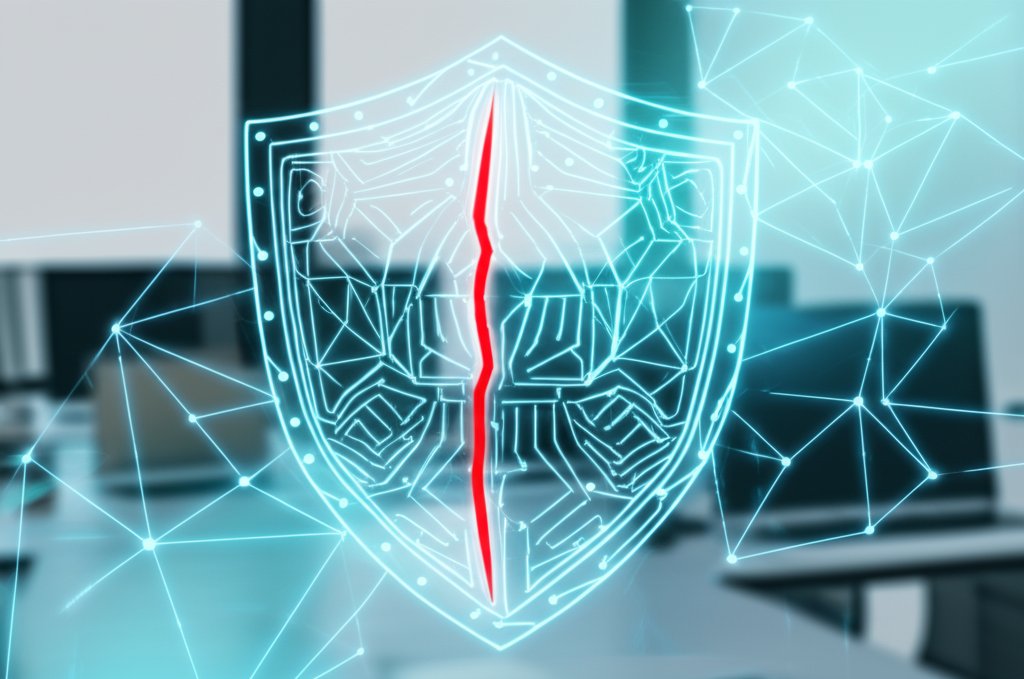Zero Trust Security: The “Never Trust, Always Verify” Model for Protecting Your Data and Small Business
For too long, our digital security has mirrored an outdated “castle-and-moat” defense. The idea was simple: erect strong firewalls (the castle walls), dig deep moats (like VPNs), and believe that once someone or something gained entry, they were generally safe and trustworthy. This model made a certain kind of sense when our digital lives were largely confined within physical office walls. However, in today’s landscape of pervasive remote work, widespread cloud services, and sophisticated cyber threats, that old assumption is no longer just naive – it’s downright dangerous.
Modern cyber threats, from advanced ransomware and widespread data breaches to cunning phishing attacks, don’t politely request entry. They exploit hidden vulnerabilities, steal legitimate credentials, and leverage the implicit trust we’ve historically granted. This is precisely why Zero Trust Architecture (ZTA) has emerged not as a fleeting buzzword, but as an indispensable, fundamental shift in our approach to security. It’s an essential strategy for everyone – from individuals safeguarding personal data to small business owners protecting their critical operations and livelihoods.
The Critical Flaws of Traditional “Castle-and-Moat” Security in the Modern Digital Landscape
Let’s delve deeper into why the “castle-and-moat” analogy is fundamentally broken for today’s digital world. Historically, cybersecurity strategies centered on perimeter-based defenses. Significant resources were poured into protecting the network’s edge – firewalls to block external threats and VPNs to securely admit authorized users. The core assumption was that anything operating inside the network’s boundary was inherently trustworthy. Once past the initial gatekeeper, users and devices often had extensive, unchecked access.
However, the realities of modern digital life have exposed critical vulnerabilities in these aging castle walls:
- The Distributed Workforce: Remote and Hybrid Environments: Your “castle” is no longer a single, physical building. Employees access critical resources from homes, co-working spaces, and while traveling. How can you effectively fortify your remote work security when a perimeter is constantly shifting and expanding globally?
- The Pervasiveness of Cloud Services and Distributed Data: A substantial portion of our data and applications now reside outside traditional on-premises networks, hosted by various cloud providers. We don’t “own” the underlying infrastructure, meaning physical network walls offer no protection for these vital cloud-based assets.
- The Rise of Personal Devices (BYOD): Employees frequently use their own laptops, tablets, and smartphones to access sensitive business data. These personal devices often lack the stringent security controls of company-issued hardware, introducing significant and diverse vulnerability points.
- Sophisticated Cyberattack Methodologies: Today’s attackers are highly adept. They often bypass the firewall entirely by using stolen credentials obtained through phishing to simply “walk through the front door” as a seemingly “trusted” employee. Once inside, they move laterally and freely, escalating privileges and causing maximum damage with minimal resistance.
- The Overlooked Threat of Insider Risks: Not all dangers originate from external hackers. An insider threat could be an employee making an honest mistake, clicking a malicious link, or even a disgruntled staff member deliberately causing harm. Traditional security models often implicitly trust these insiders, leaving organizations dangerously exposed.
As these points illustrate, the outdated perimeter-focused security model is no longer sufficient. It leaves us vulnerable precisely where robust protection is most critical.
Zero Trust Security: Embracing the “Never Trust, Always Verify” Philosophy
If we can no longer implicitly trust the network perimeter, what then do we trust? With Zero Trust network security, the answer is profoundly simple: nothing implicitly. Zero Trust Architecture (ZTA) is a strategic security framework that mandates rigorous identity verification for every user, device, and application attempting to access any resource. It operates on the principle that trust is never granted by default, regardless of whether the entity is inside or outside the traditional network boundary. The unwavering mantra is: “Never trust, always verify.”
Imagine it as an intensified airport security for your data, but with continuous scrutiny. Every individual, every device, and every data request is meticulously checked and re-checked; a single successful verification doesn’t grant unfettered access. Zero Trust isn’t a single product to purchase; it’s a holistic strategy, a fundamental and pervasive shift in your organization’s security mindset and operational approach.
The Core Pillars of Zero Trust: What ‘Never Trust, Always Verify’ Truly Means
While the concept of ZTA might initially seem daunting, its foundational principles are remarkably logical and designed for robust security:
- 1. Verify Explicitly: Always Authenticate and Authorize.
What it means: Security decisions are based on all available data points, not just location. This involves continuous, dynamic verification of who a user is and what device they are using. Beyond strong, unique passwords, this critically mandates multi-factor authentication (MFA) for every login. It also includes rigorously checking the security posture of a device – ensuring it’s updated, free of malware, and compliant with security policies – before granting access.
- 2. Least Privilege Access: Grant Only the Minimum Necessary Permissions.
What it means: Users, applications, and devices are granted access only to the specific data or applications they absolutely need to perform their assigned functions, and only for the precise duration required. For example, an employee needing to access a particular project document receives access to that document alone, and nothing more. This significantly limits the potential damage if an account or device were ever compromised.
- 3. Assume Breach: Prepare for the Worst-Case Scenario.
What it means: Operate under the assumption that an attacker is already inside your network or will eventually breach defenses. The focus isn’t solely on preventing entry but on designing your entire security infrastructure to contain, detect, and minimize the impact of a breach once it occurs. This necessitates comprehensive planning for incident detection, rapid response, and effective recovery strategies.
- 4. Microsegmentation: Isolate and Secure Network Zones.
What it means: Instead of a single, broad, open network, the digital environment is divided into many small, isolated, and highly secure segments. Each segment has its own granular access controls. If an attacker manages to penetrate one segment (e.g., the marketing department’s shared files), they are severely restricted from moving laterally to other critical segments (e.g., financial records or HR data). This dramatically limits an attacker’s ability to navigate and exploit your digital estate.
- 5. Continuous Monitoring: Maintain Constant Vigilance.
What it means: All network traffic, user behavior, and device activity are actively and continuously monitored for any anomalies or suspicious patterns. This goes beyond simple logging; it involves real-time analysis to detect deviations from normal behavior and trigger immediate alerts and responses. If an account suddenly attempts to access data it has never accessed before, or from an unusual geographical location, that’s a critical red flag demanding instant investigation.
The Tangible Benefits of Zero Trust: Fortifying Your Digital Defenses
Embracing Zero Trust isn’t about adding complexity; it’s about systematically building a more resilient, transparent, and inherently safer digital environment. Here’s why this security paradigm is critical for both your personal and business security:
- Defeats Advanced Cyber Threats: By eliminating implicit trust and enforcing continuous verification, Zero Trust dramatically enhances protection against sophisticated attacks like ransomware, phishing campaigns, and malware, preventing them from spreading rapidly once an initial foothold is gained. It makes lateral movement for attackers exceedingly difficult.
- Mitigates Insider Dangers: Whether the risk stems from an accidental click or a malicious insider, Zero Trust significantly reduces exposure. Because access is always verified and strictly limited (least privilege), the potential impact of an insider threat is severely curtailed.
- Secures Remote Work and Cloud Adoption: In our hybrid work reality, Zero Trust ensures secure and compliant access to resources from any location, on any device. Your team can work confidently from anywhere, knowing their connection and access are continuously validated and protected.
- Reduces Your Attack Surface: By implementing least privilege access and microsegmenting your network, you create fewer potential entry points and pathways for attackers to exploit. It transforms your environment from one large, open hall into numerous tiny, securely locked rooms.
- Boosts Data Protection & Governance: Sensitive information receives dynamic, robust protection irrespective of its storage location or access point. This ensures your critical data is safer both in transit and at rest, enhancing overall data governance.
- Facilitates Regulatory Compliance: Zero Trust principles inherently align with many stringent data privacy regulations (such as GDPR, HIPAA, and CCPA) by enforcing rigorous access controls, detailed logging, and comprehensive audit trails. This proactive alignment can significantly streamline your efforts in meeting complex compliance requirements.
Zero Trust in Practice: Actionable Steps for Individuals and Small Businesses
While implementing a full-scale Zero Trust Architecture can be a substantial undertaking for large enterprises, its core principles are highly actionable for individuals and small businesses. You can significantly enhance your security posture without requiring a massive budget or deep technical expertise. Here’s how to begin your Zero Trust journey:
For Everyday Users: Empowering Your Personal Digital Security
Your personal digital life is a treasure trove for cybercriminals. Adopt these Zero Trust principles to protect it:
- Master Multi-Factor Authentication (MFA): This is your single strongest defense against stolen passwords. Enable MFA on all your critical online accounts – email, social media, banking, shopping, cloud storage, and any service holding sensitive data. Even if a hacker obtains your password, MFA ensures they cannot access your account without that crucial second verification step.
- Cultivate Strong, Unique Passwords: Leverage a reputable password manager to generate and securely store complex, unique passwords for every single online account. Never reuse passwords across different services. This directly embodies the “verify explicitly” principle, ensuring each access point is independently secured.
- Keep Everything Updated: Regularly update your operating systems (Windows, macOS, iOS, Android), web browsers, applications, and antivirus software. These updates frequently include critical security patches that close known vulnerabilities which attackers actively seek to exploit.
- Embrace Skepticism (Phishing Awareness): Approach every unsolicited email, text message, or clickable link with extreme caution. Never click suspicious links, open unexpected attachments, or download files from unverified sources. Always verify the sender and the context before interacting. Adopt a Zero Trust mindset: assume malicious intent until proven otherwise, especially to avoid critical email security mistakes.
- Understand and Limit Permissions: Be judicious about the permissions you grant to apps and websites accessing your personal data, microphone, or camera. Practice the principle of least privilege in your personal digital life, giving only the minimum necessary access.
Implementing Zero Trust for Small Businesses: Practical Strategies and Considerations
Small businesses are often targeted because they are perceived as having weaker defenses than large corporations. Zero Trust offers a pragmatic path to robust security:
- Start Small and Prioritize Your Crown Jewels: You don’t need to overhaul your entire infrastructure overnight. Begin by identifying your most critical data, applications, and systems. What would be catastrophic if compromised? Focus your initial Zero Trust efforts on these high-value assets. A simple risk assessment can guide this prioritization.
- Implement Robust Identity and Access Management (IAM) with MFA: This is the cornerstone. Enforce strong IAM for all employees, contractors, and devices. Every user must have MFA enabled across all business applications. If you utilize cloud services like Microsoft 365 or Google Workspace, their business plans typically include powerful IAM and MFA capabilities that you can configure and leverage immediately.
- Enforce the Principle of Least Privilege: Conduct a thorough audit of employee access permissions. Ensure staff members only have access to the data, systems, and applications absolutely necessary for their specific roles. Regularly review and revoke access when roles change or employees depart. This is a crucial element of Zero Trust for applications and data.
- Secure and Monitor All Accessing Devices: Ensure all devices – whether company-owned or personal (BYOD) – that access business resources meet stringent security standards. This includes up-to-date operating systems, active endpoint protection (antivirus/anti-malware), and potentially device encryption. Consider lightweight Mobile Device Management (MDM) or Unified Endpoint Management (UEM) solutions to enforce these policies and perform health checks before granting access.
- Leverage Built-in Cloud Security Features: Many popular cloud providers (Azure, AWS, Google Cloud) offer robust, built-in Zero Trust capabilities within their existing security suites. Explore features like conditional access policies, data loss prevention (DLP), and advanced threat protection already available in your current cloud subscriptions. These can provide significant layers of protection often without separate investment.
- Implement Basic Network Segmentation (Microsegmentation): Even at a small business scale, you can start segmenting your network. For instance, separate guest Wi-Fi from internal networks, or isolate critical servers (e.g., accounting, customer databases) onto their own network segments or VLANs. This limits an attacker’s ability to move freely if they compromise one part of your network.
- Conduct Regular Reviews and Proactive Monitoring: While a dedicated security team might be out of reach, periodically audit access permissions and establish basic monitoring for unusual activity. This could involve regularly reviewing system logs for anomalous login attempts, unexpected data access patterns, or unusual network traffic. Set up alerts for critical events.
- Continuous Employee Training and Awareness: Your team is your most vital first line of defense. Continuously educate staff on cybersecurity best practices, the evolving dangers of phishing and social engineering, and the critical “never trust, always verify” mindset. Empower them to be proactive participants in your overall security solution through regular training and awareness campaigns.
Building a Resilient Digital Future: Your Path to Enhanced Security with Zero Trust
Zero Trust Security is far more than a passing trend; it represents the necessary and logical evolution of cybersecurity for our increasingly interconnected, cloud-centric, and threat-laden digital world. The traditional, perimeter-focused methods of securing our digital assets are no longer adequate against today’s sophisticated adversaries. By decisively embracing the principle of “never trust, always verify,” we can construct far more robust, adaptive, and resilient defenses against the complex cyber threats we encounter daily. To ensure successful implementation, it’s also crucial to understand common Zero Trust failures and how to avoid them.
You don’t need to be a cybersecurity expert or possess an unlimited budget to embark on this journey. By thoughtfully adopting even a few core Zero Trust principles – such as consistently enabling multi-factor authentication, utilizing strong, unique passwords, and maintaining a healthy skepticism towards unsolicited digital communications – you can dramatically enhance your security posture. This applies equally whether you’re safeguarding personal memories or protecting the critical data that fuels your small business. Take control of your digital security today. Start with a password manager and 2FA; your digital future depends on it.









